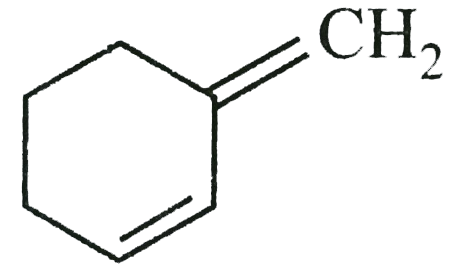A will ……..by E1 reaction
 .
.

 .
.
 .
.
(##A2Z_CHM_XII_MOC_C03_E01_013_O04.png" width="30%">.
The correct Answer is:C
 .
.
Topper's Solved these Questions
- MOCK TESTBOOK - A2ZCHAPTER - MOCK TESTEXERCISE - Assertion-Reasoning
5 Videos
- GENERAL PRINCIPLES AND PROCESS OF ISOLATION OF METALSBOOK - A2ZCHAPTER - GENERAL PRINCIPLES AND PROCESS OF ISOLATION OF METALSEXERCISE - Section D - Chapter End Test
30 Videos
- ORGANIC COMPOUNDS CONTAINING HALOGENSBOOK - A2ZCHAPTER - ORGANIC COMPOUNDS CONTAINING HALOGENSEXERCISE - Section D - Chapter End Test
30 Videos
Similar Questions
Knowledge Check
Which of the following compounds will give E1 reaction?
A BPh−Br∣CH−CH3CH2C=CH−Cl∣CH−CH3D
BPh−Br∣CH−CH3CH2C=CH−Cl∣CH−CH3D
Which of the following compounds will give E1 reaction?
A BPh−Br∣CH−CH3CH2C=CH−Cl∣CH−CH3D
BPh−Br∣CH−CH3CH2C=CH−Cl∣CH−CH3D
Which of thye following will be most reactive for E1 reaction ? .
A BC6H5−CH−BrCCH2=CH−Br∣CH−CH3DCH2=CH−Br∣C∣CH3−CH3
BC6H5−CH−BrCCH2=CH−Br∣CH−CH3DCH2=CH−Br∣C∣CH3−CH3
Which of the following can give E1 cb reaction in basic medium?
View SolutionWhich of the following can give E1cb reaction in basic medium?
View SolutionThe removal of two atoms or groups one generally hydrogen (H+) and the other a leaving group (L−) resulting in the formation of unsaturated compound is known as elimination reaction.

In E1 (elimination) reactions the C-L bond is broken heterolytically (in step 1) to form a carbocation ( as in SN1 reaction) in which (L−) is lost (rate determining step). The carbocation (in step 2) loses a proton from the β− carbon atom by a base (nucleophile) to form an alkene. E1 reaction is favoured in compounds in which the leaving group is at secondar (2∘) or tertiary(3∘) Position.
In E2 (elimination) reactions two sigma bonds are broken and a π−bond is formed simultaneously.E2 reactions occur in one step through a transition state.

E2 reactions are most common in haloalkanes (particulary 1∘) and better the leaving group higher is the E2 reaction. In E2 reactions, both the leaving groups should be antiplaner.
E1cb (Elimination unimolecular conjugate base) reaction involves the removal of proton by a conjugate base (step 1) to produce carbanion which loses a leaving group to form an alkene (step 2) and is a slow step
R2CH−C∣X−R2'+:B−(base)→R2C=CR2
+H−B+X−
this reaction is an example of:
View SolutionThe removal of two atoms or groups one generally hydrogen (H+) and the other a leaving group (L−) resulting in the formation of unsaturated compound is known as elimination reaction.

In E1 (elimination) reactions the C-L bond is broken heterolytically (in step 1) to form a carbocation ( as in SN1 reaction) in which (L−) is lost (rate determining step). The carbocation (in step 2) loses a proton from the β− carbon atom by a base (nucleophile) to form an alkene. E1 reaction is favoured in compounds in which the leaving group is at secondar (2∘) or tertiary(3∘) Position.
In E2 (elimination) reactions two sigma bonds are broken and a π−bond is formed simultaneously.E2 reactions occur in one step through a transition state.

E2 reactions are most common in haloalkanes (particulary 1∘) and better the leaving group higher is the E2 reaction. In E2 reactions, both the leaving groups should be antiplaner.
E1cb (Elimination unimolecular conjugate base) reaction involves the removal of proton by a conjugate base (step 1) to produce carbanion which loses a leaving group to form an alkene (step 2) and is a slow step
Isopropyl chloride on heating with concentrated solution of ethanolic KOH gives mainly:
View SolutionThe removal of two atoms or groups one generally hydrogen (H+) and the other a leaving group (L−) resulting in the formation of unsaturated compound is known as elimination reaction.

In E1 (elimination) reactions the C-L bond is broken heterolytically (in step 1) to form a carbocation ( as in SN1 reaction) in which (L−) is lost (rate determining step). The carbocation (in step 2) loses a proton from the β− carbon atom by a base (nucleophile) to form an alkene. E1 reaction is favoured in compounds in which the leaving group is at secondar (2∘) or tertiary(3∘) Position.
In E2 (elimination) reactions two sigma bonds are broken and a π−bond is formed simultaneously.E2 reactions occur in one step through a transition state.

E2 reactions are most common in haloalkanes (particulary 1∘) and better the leaving group higher is the E2 reaction. In E2 reactions, both the leaving groups should be antiplaner.
E1cb (Elimination unimolecular conjugate base) reaction involves the removal of proton by a conjugate base (step 1) to produce carbanion which loses a leaving group to form an alkene (step 2) and is a slow step
2-Bromonbutane on heating with concentrated solution of alcoholic KOH gives major product as :
View Solution
